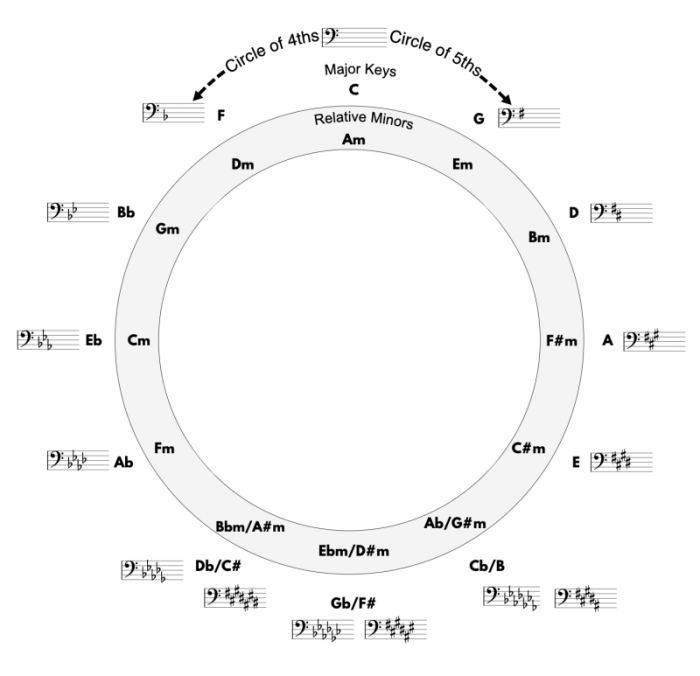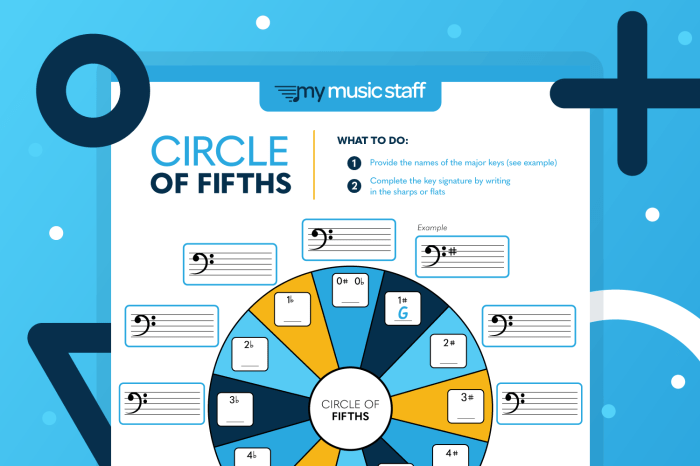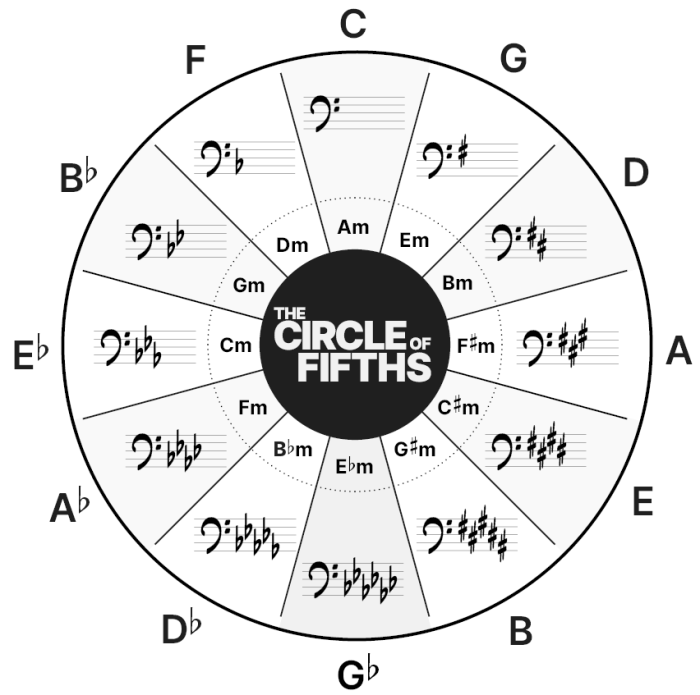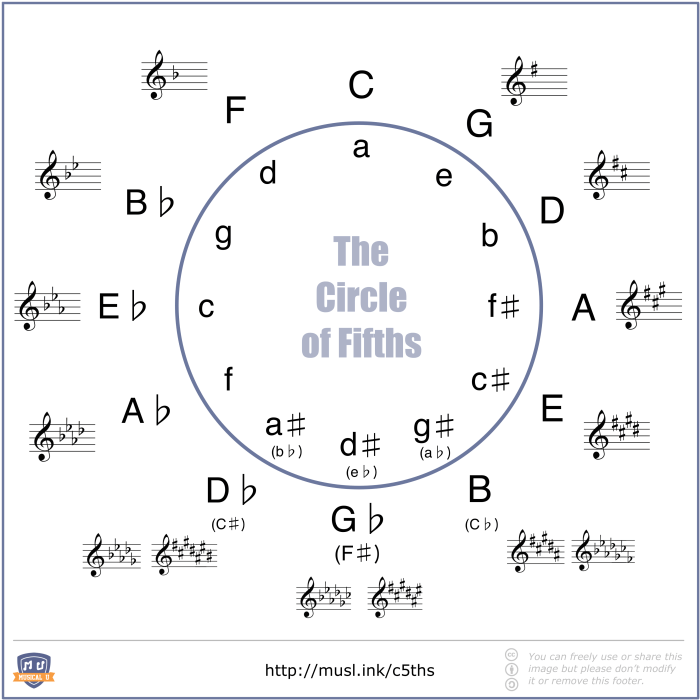The circle of 5ths bass clef is a fundamental concept in music theory that provides a roadmap for understanding the relationships between notes and keys. In this comprehensive guide, we’ll explore the intricacies of the circle of 5ths, its applications in bassline construction, and its significance in music composition.
The circle of 5ths is a visual representation of the 12 musical notes, arranged in a clockwise pattern. Each note is related to the next by a perfect fifth interval, creating a cycle that repeats indefinitely. This arrangement reveals the harmonic relationships between notes and provides a framework for understanding key signatures, scales, and chords.
Circle of Fifths in Bass Clef

The circle of fifths is a fundamental concept in music theory that describes the relationships between the 12 notes of the chromatic scale. It’s arranged in a circular pattern, with each note connected to the next by an interval of a fifth.
This pattern reveals important relationships between notes, scales, and chords, making it a valuable tool for musicians of all levels.
Diagram of the Circle of Fifths in Bass Clef, Circle of 5ths bass clef
The circle of fifths in the bass clef starts with the note C and proceeds clockwise through the 12 notes. Each note is represented by its corresponding letter name and the symbol for the bass clef:
- C (bass clef)
- G (bass clef)
- D (bass clef)
- A (bass clef)
- E (bass clef)
- B (bass clef)
- F# (bass clef)
- C# (bass clef)
- G# (bass clef)
- D# (bass clef)
- A# (bass clef)
- E# (bass clef)
Relationships between Notes and Keys
The circle of fifths not only shows the relationships between individual notes but also between keys. Moving clockwise around the circle represents increasing the number of sharps in a key signature, while moving counterclockwise represents increasing the number of flats.
This pattern allows musicians to easily identify the key of a piece of music based on its starting note.
For example, starting from C (no sharps or flats), moving clockwise one step to G adds one sharp (F#), and moving another step to D adds another sharp (C#). Conversely, moving counterclockwise from C to F adds one flat (Bb), and moving another step to Bb adds another flat (Eb).
Using the Circle of Fifths for Basslines

The circle of fifths is a valuable tool for bass players, as it can help them create basslines that are both musically pleasing and harmonically sound. By understanding how the circle of fifths works, bass players can learn to create basslines that move smoothly between chords and create a strong foundation for the music.
Common Bassline Patterns and Progressions
There are many different bassline patterns and progressions that can be created using the circle of fifths. Some of the most common include:
- Root note movement: This involves playing the root note of each chord in the progression. For example, in the key of C major, the root note movement would be C-G-D-A-E.
- Fifth movement: This involves playing the fifth of each chord in the progression. For example, in the key of C major, the fifth movement would be G-D-A-E-B.
- Octave movement: This involves playing the octave of each chord in the progression. For example, in the key of C major, the octave movement would be C-G-D-A-E-C.
These are just a few of the many different bassline patterns and progressions that can be created using the circle of fifths. By experimenting with different patterns and progressions, bass players can create basslines that are both unique and musically interesting.
Role of Root Notes and Inversions
Root notes and inversions play an important role in bassline construction. The root note of a chord is the note that gives the chord its name. For example, the root note of a C major chord is C. Inversions are created when the root note is not the lowest note in the chord.
For example, a first inversion of a C major chord would be G-C-E.
Root notes and inversions can be used to create a variety of different bassline effects. For example, playing the root note of a chord can create a strong and stable foundation for the music. Playing an inversion of a chord can create a more interesting and dynamic bassline.By
understanding how to use root notes and inversions, bass players can create basslines that are both musically pleasing and harmonically sound.
Advanced Applications of the Circle of Fifths

The circle of fifths is a powerful tool that can be used for more than just finding the key of a song. It can also be used to create tension and release, modulate to different keys, and add chromaticism to your basslines.
Modulation
Modulation is the process of changing from one key to another. The circle of fifths can be used to modulate smoothly between keys that are closely related. For example, you could modulate from C major to G major by moving clockwise around the circle.
This would create a sense of tension, as the new key is a fifth higher than the original key. You could then release the tension by modulating back to C major.
Chromaticism
Chromaticism is the use of notes that are not in the key of the song. The circle of fifths can be used to add chromaticism to your basslines by moving to adjacent keys. For example, you could add a chromatic bassline to a C major song by moving to the key of G major and then back to C major.
This would create a sense of movement and interest.
The circle of 5ths in the bass clef is a useful tool for understanding the relationships between notes. For example, moving clockwise from C, the next note is G, which is a perfect fifth above C. The next note is D, which is a perfect fifth above G, and so on.
This pattern continues around the circle. Interestingly, the Blue and Gold Award FFA program recognizes outstanding achievement in agricultural education. Similarly, understanding the circle of 5ths in the bass clef is an important achievement for musicians.
Famous Basslines and Compositions
The circle of fifths has been used in countless famous basslines and compositions. Some of the most notable examples include:* The bassline in “Billie Jean” by Michael Jackson
- The bassline in “Another One Bites the Dust” by Queen
- The bassline in “Seven Nation Army” by The White Stripes
- The bassline in “All of Me” by John Legend
- The bassline in “Superstition” by Stevie Wonder
These are just a few examples of how the circle of fifths can be used to create great basslines and compositions. By understanding the circle of fifths, you can open up a world of possibilities for your music.
Teaching the Circle of Fifths to Students: Circle Of 5ths Bass Clef

Teaching the circle of fifths to bass students can be a fun and engaging experience. By using a variety of activities, exercises, and worksheets, you can help your students understand the concept and how to use it in their playing.
Lesson Plan
Here is a sample lesson plan for teaching the circle of fifths to bass students:
- Introduction:Start by introducing the concept of the circle of fifths. Explain that it is a diagram that shows the relationship between the 12 notes of the chromatic scale.
- Activity:Have students draw a circle of fifths on a piece of paper. Then, have them label each note with its correct name.
- Exercise:Give students a series of notes and have them identify the next note in the circle of fifths.
- Worksheet:Provide students with a worksheet that contains a variety of exercises on the circle of fifths.
- Conclusion:Review the main concepts of the circle of fifths and how it can be used in bass playing.
Tips for Making the Lesson Engaging and Interactive
- Use a variety of activities and exercises to keep students engaged.
- Make sure to provide plenty of opportunities for students to practice what they have learned.
- Use real-world examples to show students how the circle of fifths can be used in bass playing.
- Make the lesson fun and enjoyable for students.
Clarifying Questions
What is the circle of 5ths?
The circle of 5ths is a visual representation of the 12 musical notes, arranged in a clockwise pattern, where each note is related to the next by a perfect fifth interval.
How can I use the circle of 5ths to create basslines?
The circle of 5ths provides a roadmap for creating basslines that are musically pleasing and harmonically sound. By understanding the relationships between notes and keys, bassists can navigate the fretboard with confidence and create basslines that drive the groove and support the melody.
What are some advanced applications of the circle of 5ths?
The circle of 5ths can be used for more advanced applications such as modulation, chromaticism, and creating tension and release in music. It also provides a framework for understanding harmony, key signatures, and scales.
